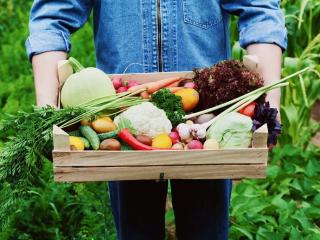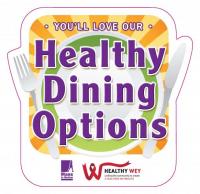Healthy Eating

What is Healthy Eating?
According to the USDA's Dietary Guidelines for Americans (2010), a healthy eating plan does the following:
- Emphasizes fruits, vegetables, whole grains, and non-fat or low-fat (1%) milk products.
- Includes lean protein such as poultry, fish, beans, eggs, and nuts.
- Is low in saturated fats, trans fats, cholesterol, salt (sodium), and added sugars.
- Stays within your daily calorie needs, typically 2,000 calories per day.
Eat More Fruits and Vegetables
Fruits and vegetables are low in calories, packed with nutrients, and have lots of fiber to keep you feeling full on the good stuff. You can never have too many fruits and vegetables, so aim for around 9-11 servings a day or more.
How many servings are you getting? One serving is equal to:
- ½ cup chopped fruits or vegetables
- 1 medium piece of fruit (the size of a tennis ball)
- ¼ cup dried fruit
- ¾ cup vegetable juice
- ½ cup 100% fruit juice
- 1 cup leafy green vegetables
If you’re eating canned fruits or vegetables, make sure the fruit is packed in its own juice, and the vegetables have no added salt.
Rethink Your Drink
Sodas, fruit-flavored juices, and other sugary drinks pack a lot of calories but no nutrients.
Next time you’re thirsty, rethink your drink. Choose water, seltzer, or non-fat or low-fat (1%) milk. They'll quench your thirst just as well, without adding extra calories.
Healthy Beverage Tips
- Drink plain, flavored, or carbonated water instead of sodas and fruit drinks.
- Have a water bottle within reach throughout the day to stay hydrated and quench your thirst.
- Buy non-fat or low-fat (1%) milk vs. whole milk.
- Add fresh fruit or a splash of 100% fruit juice, like cranberry, to plain sparkling water.
- Sweeten coffee and tea with calorie-free sweeteners and non-fat or low-fat (1%) milk.
- When you have a sugary drink, go for a smaller size, like an 8-oz can or bottle.
- Limit your intake of energy drinks. A single container contains 16-18 teaspoons of sugar.
- Enjoy a sports drink only after intense physical activity - not after moderate physical activity or as an everyday beverage. Your body needs water!
Down-Size Portions
Eating large portions adds extra calories, and extra calories can add extra weight. Use smaller plates, eat smaller bits, and take time to enjoy your meal so you don't overeat.
Many of us eat more than we think, so use MyPlate to right-size your portions.
Portion control is even more important when you're out to eat. When dining out:
- Eat only half the meal, and take the rest home.
- Order from the menu instead of the buffet.
- Choose the "small" or "medium" size for your main item, sides, and drinks. Never “supersize."
Snack Smart
For most of us, snacks act as an extra source of calories. Portion control is the key to a healthy snack.
Right-size your snacks by dividing a big bag into smaller bags, buying single-serving packs with 100 calories or less, and avoiding eating straight from the bag.
Snack Smart Tips
- Eat snacks at least 2 hours before meals so you still have an appetite.
- Choose fruits and vegetables, low-fat cheese or yogurt, a small serving of pretzels, or low-fat microwave popcorn.
- Choose fruits and vegetables that are fresh, frozen, canned, or 100% fruit juice.
- Make sure dairy products are non-fat or low-fat (1%).
- Serve nuts in small portions, paired with another healthy snack, such as fruit.
- Carry your favorite healthy snacks with you when you leave home - that way you won't be tempted to buy less healthy snacks when you're out and about.
Snack Smart Tips for Kids
- Choose cut fruits, a small box of raisins, whole-grain cereal or crackers, low-fat granola bars, and rice cakes.
- Do taste tests with your kids to try new fruits and vegetables.
- For children 6 years and over, serve snacks at least 2 hours before meals so they still have an appetite.
- For children between 2 and 5 years old, serve 2-3 snacks a day (about 1-2 hours before meal times).
- Don't use food as a reward - instead, do a fun activity!
Healthy Dining Program
More and more people are looking for healthier options when dining out. The Mass in Motion Healthy Dining Program works with local restaurants to offer healthier menu options, including smaller portions, sides of fruit and vegetables, and healthier drink choices.
Look for restaurants in Weymouth with this decal to find healthier dining options. Find a full list of participating restaurants here.
Eat Smart Everywhere You Go
Restaurant meals tend to be higher in calories and sodium, and portions are bigger than ever before.
When eating out, eat smart!
Fast Food
- Choose the "small" or "medium" size for your main item, sides, and drinks. Never "supersize."
- Choose regular hamburgers instead of double cheeseburgers with extra bacon and mayonnaise.
Sub Shop
- Choose roast beef or turkey instead of a mayonnaise-based sub, such as tuna or chicken salad.
- Choose a 6-inch sub vs. a 12-inch.
- Load your sub with lots of vegetables, such as lettuce, tomatoes, onions, pickles, peppers, and cucumbers.
Pizza
- Order pizzas with lots of vegetables and no meats - this can cut the calories almost in half.
- Ask for thin crust.
Steakhouse
- Order filets and flanks instead of steak tips.
- Avoid added butter and sauces for your steak.
- For a side, order a vegetable, baked potato, or sweet potato vs. garlic mashed potatoes.
Asian
- Avoid fried items such as egg rolls, fried rice, fried dumplings, tempura, and wontons.
- Choose dishes with lots of vegetables, such as shrimp and broccoli.
Italian
- Order pasta with marinara sauce instead of white, creamy sauces.
- Instead of pasta as a side, ask for a vegetable or salad.
- Limit yourself to one piece of bread or roll.
Mexican
- Leave off the sour cream and guacamole.
- Go easy on chips, nachos, and large fried items, like taco salads.
- If you order a large burrito, save half for later. Some burritos have up to 1,100 calories.
ChopChop Healthy Family Recipes
Preparing snacks and meals as a family can help kids develop healthy behaviors that last forever. Try one of ChopChop Magazine's heathy family recipes and have fun cooking healthy.

